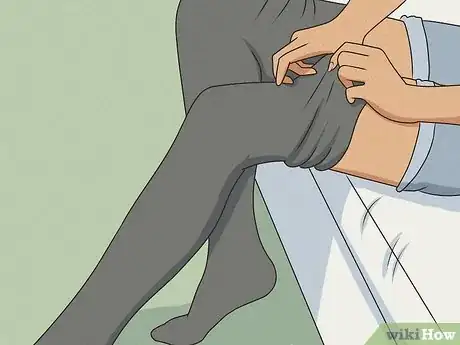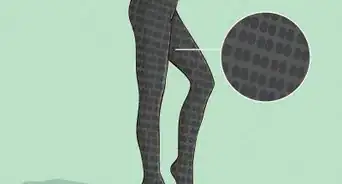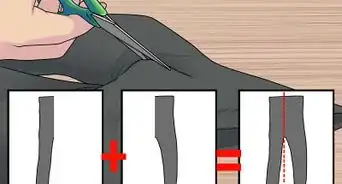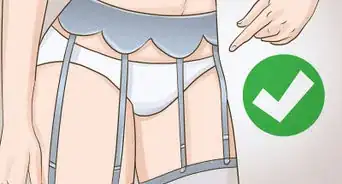X
wikiHow is a “wiki,” similar to Wikipedia, which means that many of our articles are co-written by multiple authors. To create this article, 14 people, some anonymous, worked to edit and improve it over time.
This article has been viewed 200,622 times.
Learn more...
Hosiery comes in a range of thickness and weight. The term "denier" measures both the weight and thickness of yarn (it is a combination of the terms density and linear).[1] It is useful to understand the different denier of hosiery because the weight and thickness affect style, comfort, warmth, and appearance.
Steps
-
1Understand the basics of denier. The following facts are useful to keep in mind when selecting your hosiery:[2]
- The lower the denier, the more sheer the hosiery is.
- The higher the denier, the more opaque the hosiery becomes.
- Modern styles can manage to make sheer hosiery at a higher denier to provide strength and sheerness - it depends on the brand and will definitely cost more.
-
2Learn the qualities of each denier range. The following denier counts will help you to identify which hosiery you need for each wearing occasion:
- 15 denier or less - often termed "ultrasheer": This almost appears like not wearing hosiery at all. This denier range is ideal for hot weather and for glamorous evening translucency. The downside is that this denier tends to be fragile, so keep your fingernails clear when putting on, and be careful of snagging it while wearing. Common culprits involved in snatching these include rough chairs, brushing against foliage, and the underside of tabletops.
-
15 to 30 denier - often termed "sheer": This range is the fairly standard, classic hosiery denier. It is obvious that you're wearing hosiery but good quality hosiery will give your legs an even, complete appearance. Given that this denier is stronger, it's far less likely to snag, and it's the typical weight for office wear and is also suitable for casual and evening wear.
- Don't dismiss the cheaper versions. It pays to shop around in this denier - you may be pleasantly surprised by the quality of a cheaper brand.
- 30-40 denier - often termed "semi-opaque": This range is not yet opaque and has the advantage of being stronger than sheer but still showing your skin through the texture. It's another ideal pick for office and retail assistant wear, especially for long days. Again, it can be fine for evening wear.
-
40 denier up - often termed "opaque": These are the thick members of the hosiery family (and they are referred to as "tights"). Anything 40 denier and above won't show your skin underneath unless it's really stretched when you bend your knee. Great for cold weather, this hosiery will keep your legs warm under a skirt or trouser pants (or even shorts!). This denier tends to come in a range of colors and patterns that can be carried off well because of the hosiery's thickness.
- Be careful when buying all wool tights - they can be really itchy and also cause you to overheat in constantly warm indoor environments.
- Another benefit of many thicker deniers is the ability to mend them around the toe and heel areas if they are made of durable materials such as cotton, wool, or lace. This means they last and last, several years even, if looked after well.
Advertisement -
3Take time to learn what suits you best. While it is helpful to listen to the ideas of retail assistants, friends, and others giving you advice, hosiery is a very personal experience and what works for one person may not work for you. If you try hosiery that you don't find appealing, move on to the next style or denier until you find something that works best for you. Keep in mind:
- Denier needs change according to season - if you find keeping cool or warm important, keep this in mind.
- Some fashion trends will see hosiery out of fashion altogether and that's fine too!
- There is a lot of advice about not wearing certain colors and patterns. Some of it is good advice if you're concerned about weight issues (see "Tips" below) but again, test out the look for yourself. Simply because one fashion blogger or a magazine fashion editor cannot abide one style of hosiery doesn't mean it won't work for you. The only real bar might be cost, as some of the imported hosiery is astronomically priced when it comes to just testing it out!
Advertisement
Community Q&A
-
QuestionWhat is the best denier for tights with feet?
 Community AnswerJust about any. Lightweight are good if you're used to wearing lightweight tights or pantyhose.
Community AnswerJust about any. Lightweight are good if you're used to wearing lightweight tights or pantyhose. -
QuestionI want a toeless hosiery that covers varicose veins. Which denier would you recommend?
 Community AnswerIf you're wanting the tights/stocking to cover up something, then a thicker denier would be recommended - probably at least 80-100.
Community AnswerIf you're wanting the tights/stocking to cover up something, then a thicker denier would be recommended - probably at least 80-100. -
QuestionWhat is the heaviest denier possible for tights?
 Community Answer100 denier is the heaviest in most brands. Thicker tights are very hard to find and you can still get 110 denier in Primark.
Community Answer100 denier is the heaviest in most brands. Thicker tights are very hard to find and you can still get 110 denier in Primark.
Advertisement
Things You'll Need
- Packaging information - the denier is usually printed on the packaging
- Samples - many lingerie sections will provide hosiery samples for you to feel and test the color against your skin
References
About This Article
Advertisement




























































